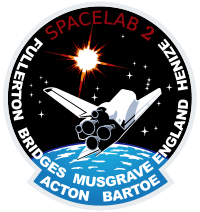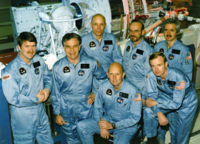- STS-51-F
-
STS-51-F Mission insignia

Mission statistics Mission name STS-51-F Space shuttle Challenger Launch pad 39A Launch date 29 July 1985, 21:00:00 UTC Landing 6 August 1985, 19:45:26 UTC
Edwards AFB, Runway 23Mission duration 7 days, 22 hours, 45 minutes, 26 seconds Number of orbits 127 Orbital altitude 173 nautical miles (320 km) Orbital inclination 49.5° Distance traveled 3,283,543 miles (5,284,350 km) Crew photo 
Front row (seated) L-R: Fullerton, Bridges, Back row (standing) L-R: England, Henize, Musgrave, Acton, Bartoe Related missions Previous mission Subsequent mission STS-51-G 
STS-51-I 
STS-51-F (also known as Spacelab 2) was the nineteenth flight of NASA's Space Shuttle program, and the eighth flight of Space Shuttle Challenger. It launched from Kennedy Space Center, Florida, on 29 July 1985, and landed just under eight days later on 6 August.
While STS-51-F's primary payload was the Spacelab-2 laboratory module, the payload which received the most publicity was the Carbonated Beverage Dispenser Evaluation, which was an experiment in which both Coca-Cola and Pepsi tried to make their carbonated drinks available to astronauts.
Contents
Crew
Position Crew Member Commander C. Gordon Fullerton
Second spaceflightPilot Roy D. Bridges, Jr.
Only spaceflightMission Specialist 1 F. Story Musgrave
Second spaceflightMission Specialist 2 Anthony W. England
Only spaceflightMission Specialist 3 Karl G. Henize
Only spaceflightPayload Specialist 1 Loren W. Acton
Only spaceflightPayload Specialist 2 John-David F. Bartoe
Only spaceflightBackup crew
Position Astronaut Payload Specialist George W. Simon Payload Specialist Diane K. Prinz Mission parameters
- Mass:
- Orbiter Liftoff: 252,855 pounds (114,693 kg)
- Orbiter Landing: 216,735 pounds (98,309 kg)
- Payload: 35,955 pounds (16,309 kg)
- Perigee: 193.9 miles (312.1 km)
- Apogee: 199.5 miles (321.1 km)
- Inclination: 49.5°
- Period: 90.9 min
Launch
STS-51-F's first launch attempt on 12 July 1985 was halted with the countdown at T-3 seconds after main engine ignition, when a malfunction of the number two Space Shuttle Main Engine (SSME) coolant valve caused the shutdown of all three main engines.
Challenger launched successfully on its second attempt at 29 July 1985, 17:00 EDT, after a delay of one hour and 37 minutes due to a problem with the table maintenance block update uplink.
Three minutes and 31 seconds into the ascent, one of the center engine's two high pressure fuel turbopump turbine discharge temperature sensors failed. Two minutes and 12 seconds later, the second sensor failed, causing the shutdown of the center engine. This was the only in-flight main engine failure of the shuttle program. Approximately 8 minutes into the flight, one of the same temperature sensors in the right engine failed, and the remaining right engine temperature sensor displayed readings near the redline for engine shutdown. Booster Systems Engineer Jenny M. Howard acted quickly to command the crew to inhibit any further automatic SSME shutdowns based on readings from the remaining sensors, preventing the potential shutdown of a second engine and a possible abort mode that may have resulted in the loss of the vehicle and crew.[1]
The failed SSME resulted in an Abort To Orbit (ATO) trajectory, whereby the shuttle achieved a lower-than-planned orbital altitude.
Mission summary
STS-51-F's primary payload was the laboratory module Spacelab-2. A special part of the modular Spacelab system, the "igloo", which was located at head of a three-pallet train, provided on-site support to instruments mounted on pallets. The main mission objective was to verify performance of Spacelab systems, determine the interface capability of the orbiter, and measure the environment created by the spacecraft. Experiments covered life sciences, plasma physics, astronomy, high-energy astrophysics, solar physics, atmospheric physics and technology research. Despite mission replanning necessitated by Challenger's abort to orbit trajectory, the Spacelab mission was declared a success.
The flight marked the first time the ESA Instrument Pointing System (IPS) was tested in orbit. This unique pointing instrument was designed with an accuracy of one arcsecond. Initially, some problems were experienced when it was commanded to track the Sun, but a series of software fixes were made and the problem was corrected.
In addition, Tony England became the second amateur radio operator to transmit from space during the mission.
The Spacelab Infrared Telescope (IRT) was also flown on the mission.[2] The IRT was a 15.2 cm aperture helium-cooled infrared telescope, observing light between wavelengths of 1.7 to 118 μm.[2] The experiment experienced some problems, such as heat emissions from the Shuttle corrupting data, but still returned useful astronomical data.[2]
In a heavily-publicised marketing experiment, astronauts aboard STS-51-F enjoyed carbonated beverages from specially-designed cans provided by competitors Coca-Cola and Pepsi.[3]
Landing
Challenger landed at Edwards Air Force Base, California, on 6 August, 1985, at 12:45:26 pm PDT. Its rollout distance was 8,569 feet (2,612 m). The mission had been extended by 17 orbits for additional payload activities due to the abort-to-orbit. The orbiter arrived back at Kennedy Space Center on 11 August 1985.
Mission insignia
The mission insignia was designed by Houston artist Skip Bradley. Space Shuttle Challenger is depicted ascending toward the heavens in search of new knowledge in the field of solar and stellar astronomy, with its Spacelab 2 payload. The constellations Leo and Orion are shown in the positions they were in relative to the Sun during the flight. The nineteen stars indicate that the mission is the 19th shuttle flight.
See also
- Space exploration
- Space Shuttle program
- Space Shuttle Challenger
- Space Shuttle Challenger disaster
- List of space shuttle missions
- List of human spaceflights chronologically
References
- ^ Welch, Brian (9 August 1985). "Limits to inhibit". Space News Roundup (Houston, TX: NASA Lyndon B. Johnson Space Center): pp. 1, 3. http://www.jsc.nasa.gov/history/roundups/issues/85-08-09.pdf. Retrieved 10 January 2010.
- ^ a b c Kent, et al. – Galactic structure from the Spacelab infrared telescope (1992)
- ^ Pearlman, Robert. "A Brief History of Space Marketing". http://www.space.com/news/spaceagencies/space_market_010531-1.html. Retrieved 20 September 2010.
External links
Space Shuttle Challenger (OV-099) Flights Status Out of service - destroyed - 28 January 1986 (STS-51-L)See also Categories:- Space Shuttle missions
- Edwards Air Force Base
- 1985 in spaceflight
- Mass:
Wikimedia Foundation. 2010.



